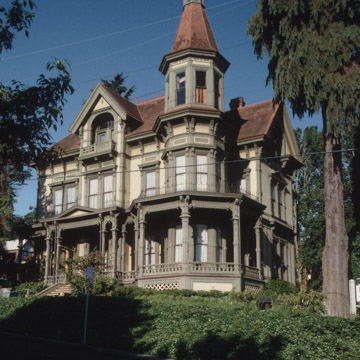You are here
Flavel House Museum
One of Oregon’s most striking mansions is that of George Flavel in Astoria. Both the house and its stable or carriage house survive nearly intact, including virtually untouched interiors with detailed hardwood casework around each of the many fireplaces. In addition to its architectural significance, however, the Flavel House is indicative of the growth of Astoria as a fishing port and of the crucial role of river pilots like Flavel, who safely navigated ships over the bar at the mouth of the Columbia River —one of the most treacherous passages anywhere in the United States.
Flavel’s skillful tenacity and fearlessness, coupled with his shrewd business sense, soon gave him a virtual monopoly on piloting services across the Columbia bar. Ship captains heading to upriver ports paid generous fees to river pilots familiar with the waters, which produced swells and waves cresting 50 feet or more where the Columbia River met the Pacific Ocean; this outflow also produced constantly shifting sand bars and ridges that could ground a ship, resulting in the loss of everything—cargo, ship, and crew. These dangers were later mitigated by twentieth-century dams and the continuous dredging and clearing of the shipping channel, but prior to that, the role of river pilot was a critical, and prosperous, career for men like Flavel.
Flavel married Mary Christine Boelling in 1854, and later expanded his business interests, which included the construction of the Occident Hotel (1869). In 1884, Flavel commissioned German-born architect Carl Leick to design a large residence for his family on a full city block at Eighth and Duane streets. Leick relocated from San Francisco for the commission, which he completed in 1888. The 11,600-square-foot mansion has an essentially square plan with a central hall. On the main floor, this hall separates the music room and dining room on one side and the stair hall, library, and parlor on the other; a kitchen wing extends from the dining room side. On the parlor’s exterior corner is an octagonal tower that rises three stories to a tall, pointed, eight-sided roof. The commanding corner tower plus the wraparound porch are hallmarks of the Queen Anne style, though individual exterior details draw from the Eastlake, Stick, and even Italianate styles; the latter seen in the prominent eave bracketing. The many decorative pilasters, moldings, and brackets were painted in a dark olive color that stood out against the goldenrod-painted shiplap siding. The red hipped roof is punctuated by large projected dormers over slightly projecting bays, introducing an irregularity belying the interior plan. Modern features for the period included full indoor plumbing and a central heating system (augmented by the coal-burning fireplaces in each of the rooms). Each room contained tall, elaborate, Eastlake-style chimney surrounds; those on the main floor were each executed in a different hardwood.
By 1887, Flavel had sold his bar piloting operation and largely retired from commercial activities. His descendants continued to live in the house until 1933, when Flavel’s grandniece, Patricia Jean Flavel, donated the mansion to the city of Astoria. Though the city used it for occasional meetings, it was later turned over to Clatsop County, which housed various agencies at the mansion from the late 1930s to early 1940s. After World War II, the house was vacant and deteriorating. The Clatsop County Historical Society assumed ownership in 1951 and operated the mansion as a historical museum. During the 1990s, the Society restored the mansion to its appearance during George and Mary Flavel’s occupancy.
References
Writing Credits
If SAH Archipedia has been useful to you, please consider supporting it.
SAH Archipedia tells the story of the United States through its buildings, landscapes, and cities. This freely available resource empowers the public with authoritative knowledge that deepens their understanding and appreciation of the built environment. But the Society of Architectural Historians, which created SAH Archipedia with University of Virginia Press, needs your support to maintain the high-caliber research, writing, photography, cartography, editing, design, and programming that make SAH Archipedia a trusted online resource available to all who value the history of place, heritage tourism, and learning.














